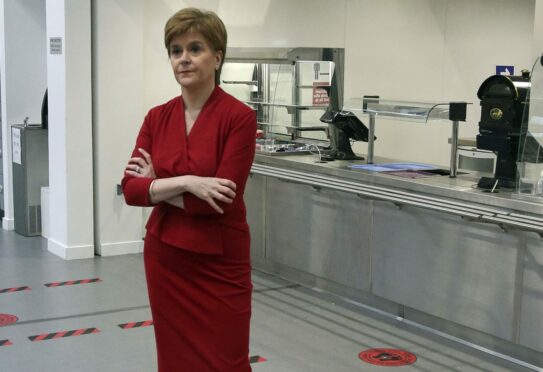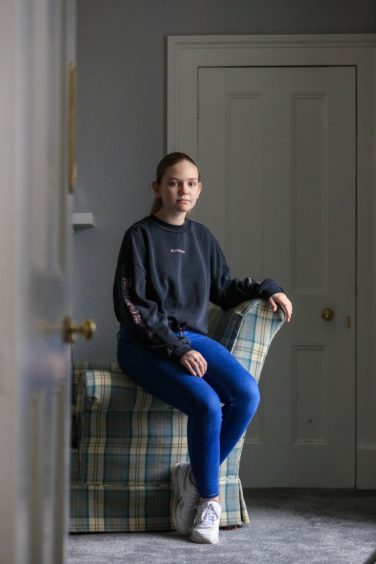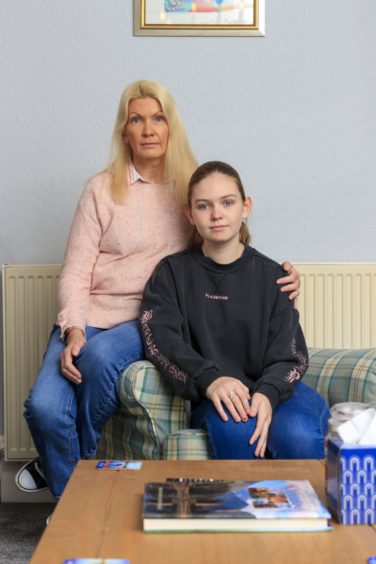
Government advice to introduce measures to secure good ventilation in classrooms and protect children have been ignored by some Scots councils, we can reveal.
Local authorities were given £100m to invest in air monitors and improve ventilation in schools but some have not bought a single monitor despite the first minister insisting all schools must have them.
Experts say carbon dioxide (CO2) monitors can indicate if exhaled Covid particles are more likely to be in the air and alert teachers if windows and doors need to be opened.
Face coverings for high school pupils during the first six weeks of term is one of the few Covid restrictions remaining in schools but Education Secretary Shirley-Anne Somerville said last week she wants that requirement dropped as soon as possible.
‘Relaxed atittude’
Retired NHS paediatrician Mike Downham said this suggests a relaxed attitude to children catching Covid that is not justified. He said: “The failure of some councils to follow recommendations is part of a wider attitude that the government must be doing the right thing by allowing infection to spread, because governments know best.
“Long-term significantly disabling symptoms in children following Covid infection are sufficiently common that we have to do everything we can to protect them from infection. It’s not enough to say they mostly don’t get ill enough to need hospitalisation.”
The UK Office for National Statistics’ latest report on ongoing symptoms published in April estimates that 12.9% of UK children aged two to 11, and 14.5% of children aged 12 to 16, still have Covid symptoms five weeks after their first infection.
The Scottish Government initially handed councils £90m to improve protection measures so that schools comply with new guidance on reducing the risk of transmission in schools.
In a letter dated July 26 seen by The Post, Education Secretary Shirley-Anne Somerville said: “Exactly how this funding is invested at a local level is a matter for local authorities/schools to decide. The regulations state every part of the school building should be provided with means of adequate ventilation and we expect all local authorities to meet this requirement.”
A further £10m was announced on August 3 by First Minister Nicola Sturgeon who said schools must have access to CO2 monitoring to assess the quality of ventilation and identify any necessary improvements.
She said: “Ventilation is one of the most important ways in which the risk of Covid transmission can be reduced – and so improving it will be vital, now and in the future, to ensure that schools and childcare centres are as safe as possible.”
However, freedom of information responses show some local authorities have yet to spend a single penny on monitors.
Helen Goss, of support group Long Covid Kids Scotland, said: “Unfortunately, it appears many local councils have not made significant or meaningful improvements to school safety. Inclement winter weather would require windows and doors to be closed. Schools will be faced with the unpleasant choice of either having very cold children in their classrooms or risk increased transmission of Covid and other winter bugs.”
Council plans
North Lanarkshire Council said there are no plans to install monitors in any of its 162 schools and they will rely on “natural ventilation”. Scotland’s largest local authority, Glasgow, which has 228 schools, told staff to open windows and doors if worried about air quality but suggested this must be balanced against “thermal comfort”. The council has spent £15,000 on CO2 monitors but did not say how many were bought.
Aberdeenshire has bought 25 monitors for £3,000 but the local authority has 167 schools. Dumfries and Galloway has six monitors for 115 schools. West Dunbartonshire Council has bought five CO2 monitors for 67 schools. Inverclyde has monitors fitted in 17 of its 28 schools,
Meanwhile, Shetland, one of Scotland’s smallest councils, has already distributed 382 monitors to its 29 schools, Angus has bought 429 monitors for 59 schools and West Lothian has given a monitor to every teacher.
Edinburgh, Falkirk and Moray have issued at least one portable CO2 monitor to each school. Several local authorities did not provide information despite repeated requests.
The UK Government is going to hand out around 300,000 carbon dioxide monitors to state schools in England before schools go back in September.
Dr Jeremy Rossman of the University of Kent, who is an expert on infectious disease outbreaks, said: “We know that children can be infected with the virus, can develop severe disease and can transmit the virus, albeit at lower rates than adults. Children are also at risk of developing persistent long-term debilitating symptoms.
“As new more-transmissible variants emerge, such as the Delta variant, the risks of children getting infected significantly increases, especially when schools are not taking comprehensive mitigation measures to prevent the spread of the virus.”
Professor Andrew Watterson, an expert in public health at the University of Stirling, said: “Office for National Statistics data for 12 to 16 year olds in the spring of 2021 shows 13% get Long Covid symptoms. Other studies on Long Covid and unvaccinated children suggested between 1.6 and 4.4%.”
The UK health regulator has approved the Moderna and Pfizer coronavirus vaccines for children over the age of 12.
All teenagers aged 16 and 17 in Scotland are already being offered a vaccine but those aged 12 to 15 are only offered it if their health leaves them at higher risk, or if they live with an immunosuppressed person.
The Scottish Government said: “We have made clear that the additional funding provided may only be used for the purposes of ensuring all schools and childcare settings have access to CO2 monitoring, whether fixed or mobile, to help improve ventilation. The Scottish Government will request regular updates on progress from all local authorities.”
Cosla, which speaks for local authorities, said: “We worked with the Scottish Government and received additional funding to expand the use of CO2 monitoring in line with new advice subject to any issues regarding the supply of monitors.”
I get migraines and I’m so tired all the time. My Covid symptoms just carried on
– Young Long Covid sufferer Elizabeth Jelley
The scale of the health issues linked to Long Covid in children and young people remains unclear as scientists and doctors wait for better data but it is already clear young people are suffering long-lasting, debilitating symptoms months after the virus.
Amanda Jelley’s daughter Elizabeth, 15, caught Covid 15 months ago but still suffers severe fatigue, muscle pain, migraines and other symptoms. Amanda, who lives in Huntly, Aberdeenshire, said: “In December 2019 Elizabeth was winning medals for skiing in a schools competition. She was a really active child. Now she can barely walk a mile a day. It has been a huge shock for her.
“She hasn’t seen her friends since last year. She can go months in the house without seeing anyone. She keeps in touch online but she doesn’t feel well enough to see people, which is really hard.”
Elizabeth said: “I never got ill before. But the symptoms of Covid have just carried on. I’ve been so tired and some days my brain won’t compute anything. I have been having migraines at least once a week.
“I can’t stay awake long enough to catch up on school work. I can’t afford to miss any more because I have exams next year.”
Her mum, 51, is a trained nurse but can’t work because a neurological condition left her registered blind. Her husband, Graham, works in Saudi Arabia but has been unable to travel home regularly due to the pandemic.
She said: “It’s really hard and there is just no help. The GP was supportive in theory but there is not a lot he can do. We were referred to a paediatrician who openly admitted they know nothing about Long Covid.
“We had to do the research and I put my foot down and she has now been referred to a chronic fatigue clinic.
“We’ve also had her at a private paediatrician in England. We couldn’t get the NHS to approve the tests so we had to get on a train to London and pay for tests, which cost us about £700. It’s ludicrous.”
Fardos MacMillan’s six-year-old son Harley has had symptoms of Covid since he caught it at school in Inverness in March this year.
She said: “Three weeks after he tested positive he had to be taken to hospital by ambulance to Raigmore Hospital because he was in respiratory distress. He also had a temperature.
“My son is asthmatic so they have bumped up his medication since but the doctors said he had inflammation in his lungs caused by Covid. They said give it 12 weeks and if he’s not getting better, he’s got Long Covid.
“It’s been six months and he’s still getting fevers, he’s absolutely exhausted all the time and his chest regularly flares up and he struggles to breathe.
“The asthma nurse has been supportive and the GP has referred him to a respiratory physio, which has helped.
“But I’m terrified about him being back in school because he might catch Covid again, which could set him back further.”

Enjoy the convenience of having The Sunday Post delivered as a digital ePaper straight to your smartphone, tablet or computer.
Subscribe for only £5.49 a month and enjoy all the benefits of the printed paper as a digital replica.
Subscribe © Ross Johnston/Newsline Media
© Ross Johnston/Newsline Media © Ross Johnston/Newsline Media
© Ross Johnston/Newsline Media